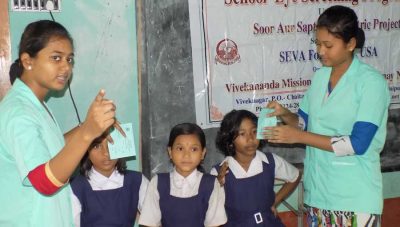Join a powerful, unprecedented alliance for better eye health for all.
Join IAPB-
Choose an alternate language here
Despite the vast amount of work that has been done to improve gender equity in eye health, still, there is a long way to go to ensure this positive intention is a ground reality. We know that 55% of the world’s visually impaired are women.
Studies have shown that barriers such as poverty, social stigma, independent decision making, illiteracy, cultural biases, limited access to finance, education and professional opportunities, systematic vulnerabilities, lack of access to information, and perceived value of eye care are some of the major challenges women face in accessing eye care. Therefore, a multidimensional approach is needed.
The Gender Development Index of India, Bangladesh, and other major South Asian countries shows that women earn much less in terms of per capita income, do not get equal education, and score less than men in most parameters of the Human Development Index. Given the higher life expectancy among women, it is fair to say that women need comparatively more eye care services than men, and therefore 50% of women having access to eye health services is not enough as a baseline, to begin with.
Over the past five years, Seva worked with Seeing is Believing and other donors to provide eye care through the Global Sight Initiative. We recently analyzed two major eye health care interventions within Seva Foundation’s Programmes in India, Nepal, and Bangladesh to better understand the situation on the ground:
Primary Eye Care Vision Centers (VC): Vision Centers provide easily accessible primary eye care services. Seva and partners established 36 VCs between June 2016 to May 2019 with similar programme design and efforts with respect to providing eye care to women. These VCs reached more than 270,000 people and provided 174,720 eye care services (including medical treatment, spectacles, surgeries and referrals). Overall, 49% of the people who received services were female. This discrepancy was greater among children, with only 43% of children seen being female. However, when we looked closer, we found that VCs established in Nepal, Bangladesh and West Bengal in India actually saw more women when compared to the rest of the programmes.
“Women find Vision Centers easily accessible from home. It is not only the question of less traveling; they feel more comfortable in the environment of Vision Centers. Common villagers feel lost in the crowd at busy hospitals” Dr Asim Sil, Netra Niramay Niketan Vivekananda Mission Ashram West Bengal, India
Pediatric screening programme (pre-school and school level): The evidence from Seva’s pediatric screening programme in Maharashtra, Delhi and West Bengal in India shows that girls have reduced access to eye care services even at school. In the data set of eye screening services for more than 220,332 children, only 47% of children screened were girls. An even smaller number of girls received glasses against the number of girls advised to get glasses. The low rate of spectacle acceptance for girls is surprising, in part, because the programme had a built-in component providing free eyeglasses to address one of the major barriers facing women and girls.

You don’t manage what you don’t track: Seva started empowering its partner hospitals under the Global Sight Initiative (GSI) to collect and analyze gender segregated data in 2016, and it is through this disaggregation that the programme learned these insights on gender disparities prevailing on the ground.
Data is key to building the system and approaches for improved access, referral, acceptance, and positive outcomes at our partner hospitals. When hospitals look at their data, they can identify some of these anomalies.
Insights from a gender survey among Global Sight Initiative (GSI) Partners in India;
In 2019-20, Seva conducted a survey of partner hospitals to better understand the practices and programme activities developed to increase the utilization of hospital services by women and girls. Findings highlighted that only 40% of hospital partners use gender disaggregated data to assess or inform their services to female patients. In fact, a main reason for collecting this gender disaggregated data is to report back to donors. While recognizing that reaching women is an important part of community eye care, most partner hospitals indicated that they did not have programmes designed to specifically reach women and girls.
Further, partner hospitals also shared a host of initiatives that they believed helped to increase gender equity at the hospital. These include:
Systemic inequality is prevalent even today when it comes to access to care for women and girls. This is as true for eye care as it is for healthcare. Seva plans to continue working with partners to collect reliable data and draw insights from it that can help inform our decisions for tomorrow. Seva works tirelessly toward a better tomorrow where all women and girls have access to eye care, where all women and girls can see clearly.
Authors: Kuldeep Singh and Heidi Chase, Seva Foundation